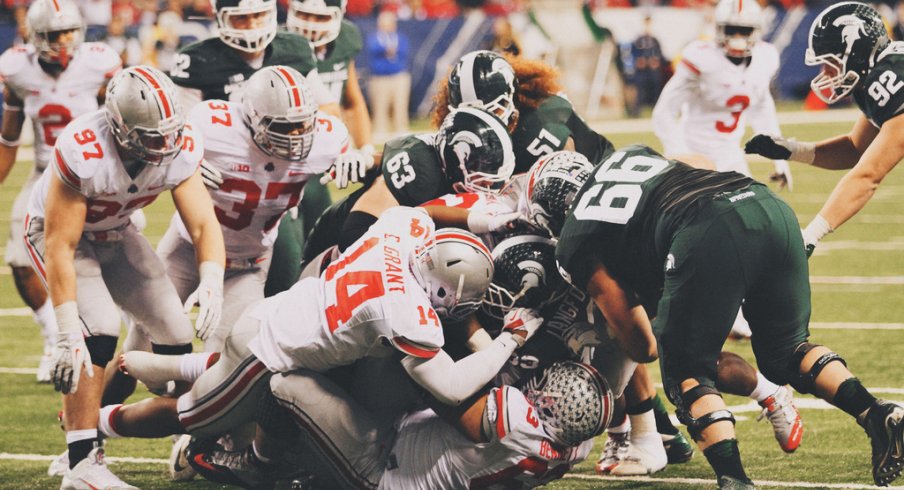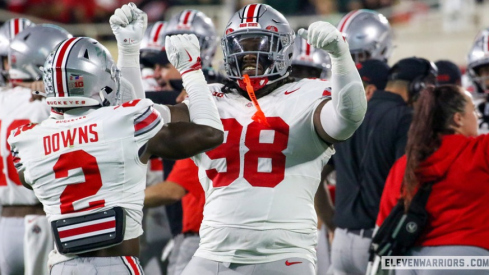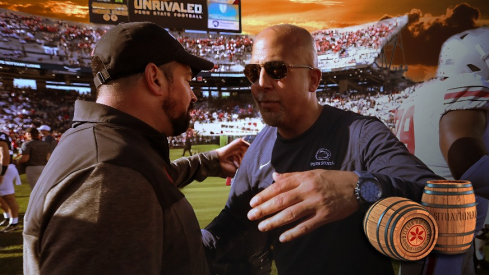The year was 2006, and Ohio State's linebacker corps had suffered a major shock.
Led by the fearsome trio of A.J. Hawk, Bobby Carpenter and Anthony Schlegel, the 2005 Buckeyes had one of the best defenses in the country. But with all three graduating, everyone thought the linebackers would be Ohio State's weakest unit. Sure, Marcus Freeman was good, but OSU would have to start an unproven sophomore with a weird Greek surname. How could some scrub named James Laurinaitis replace Hawk? It would never work.
The point is this: Sometimes, defenses lose a fantastic player only to discover somebody was waiting in the wings who could fill that role perfectly. In 2014, Ryan Shazier is the hotshot first round draft pick; now, can any of Shazier's backups measure up to his productivity?
Ryan Shazier had a statistically dominant season: 134 tackles, 94 of them unassisted, and 22.5 tackles for loss. If not for media darling Chris Borland, Shazier would have won the Big Ten Defensive Player of the Year and Butkus award to go along with his first-team All-America selection.
Above all else, Shazier's play was based on athleticism and quick thinking. When he saw where you were going and how he was going to get there, boom.
Not all tackles are alike; an aggressive linebacker who cuts off the hole and stops the running back is far more valuable than a passive linebacker who tackles the running back eight yards downfield. It's a good thing, then, that Shazier was an aggressive, pressuring linebacker: in addition to his tackles for loss, he also caused six sacks, six QB hurries, and four forced fumbles last year.
Aside from his very fun hits, though, Shazier's game had some flaws. Early in his career, he'd read his keys wrong and fly off in the wrong direction; he improved, but he still contributed to unsound defensive play as a junior. When he read plays wrong and took himself out of position, he had to rely on athleticism to make up for the mistakes.
Though Shazier's run defense was stellar, he sometimes failed to break free of blockers. On Clemson's first drive he is shoved away from the play, and right after that he can't disengage the pulling guard to keep Tajh Boyd from cruising to a touchdown.
A few other pesky flaws show up: Shazier can't contain a wide receiver from curling around him and he tends to go for kill shots at the expense of form tackling. 3:41 is an unusual case of him not committing to the pocket and making the tackle downfield when he could have stopped the run with a less passive response.
THE REPLACEMENTS
Now that we have a vague idea of Shazier's limitations, we can set criteria for his successors. Those criteria are:
- Matching Shazier's bursts of speed
- Disengaging on blocks and forcing contact closer to the line of scrimmage
- Consistent form tackling
- Pressuring the quarterback
To this end, I see four Buckeyes who could match Shazier's productivity: Curtis Grant, Josh Perry, Camren Williams, and Raekwon McMillan.
Grant and Perry are OSU's two starting linebackers that return from last year's team. They are experienced, which is both a curse and a blessing; they will be steadier than the underclassmen, but they also have less room for growth. Though both players were respectable last year, they weren't stars like Shazier was in his three seasons.
Behind those two players are a thin ensemble of unproven backups and hotshot freshmen: Raekwon McMillan, Trey Johnson, Darron Lee, Camren Williams, and Joe Burger. This group is more likely to have a breakout star, but these players have a greater chance of flaming out.
Of this group, true freshman Raekwon McMillan is most likely to become a superstar. I'm not sure Grant or Perry has the requisite athleticism to duplicate Shazier's season; the one guy I'm sure has that ability is McMillan.
With the talent of the individual players accounted for, the other contributor to success is coaching. Hawk, Laurinaitis, and plenty of other linebackers flourished under Jim Heacock, thanks to solid defensive schemes and short, easy tackles. Luke Fickell's defense last year also racked up tackles, but an alarming number of them were of the 15 yards downfield variety.
With Chris Ash looking to install a coherent defensive strategy, Fickell can spend more time on his responsibilities as a position coach. If all goes according to plan, the Buckeyes' pass defense will improve, allowing the linebackers to play aggressively. And then we can answer the question on everyone's mind: do any of Ohio State's linebackers have what it takes to be the next Ryan Shazier?


